Известные картины
- «Автопортрет в четырнадцатилетнем возрасте» (Self-portrait at the Age of 14 , 1841, Оксфорд)
- «Ф. Д. Стивенс» (F.G. Stephens , 1847, галерея Тейт, Лондон)
- «Иисус и две Марии» (Christ and the Two Marys , 1847 и 1897)
- «Риенци» (Rienzi vowing to obtain justice for the death of his young brother, slain in a skirmish between the Colonna and the Orsini factions , 1848-49)
- «Страшный двор» (The Haunted Manor , 1849, галерея Тейт, Лондон)
- Cornfield at Ewell , 1849, галерея Тейт, Лондон.
- «Английское семейство, обращённое в христианство, защищает проповедника этой религии от преследования друидов» (1849-50, Оксфорд)
- «Клаудио и Изабелла» (Claudio and Isabella , 1850-53, галерея Тейт, Лондон)
- «Пробудившийся стыд» (The Awakening Conscience , 1851-53, галерея Тейт, Лондон)
- Our English Coasts , 1852, галерея Тейт, Лондон
- «Светоч мира» (The Light of the World , 1853—184)
- The Afterglow in Egypt , 1854-63, Оксфорд
- «Козел отпущения (картина)» (The Scapegoat , 1854-56)
- The School-girl’s Hymn , 1858-59, Оксфорд
- «Нахождение Спасителя во Храме» (The Finding of the Saviour in the Temple ), 1854—1860
- The Festival of St. Swithin (The Dovecot) , 1865-66, Оксфорд
- Isabella and the Pot of Basil , 1868
- «Тень смерти» (The Shadow of Death , 1870-73)
- The Plain of Esdralon from the Heights above Nazareth , 1877, Оксфорд.
- The Triumph of the Innocents , 1883—1884), галерея Тейт, Лондон.
- «Леди из Шалотта» (The Lady of Shalott , вместе с Хьюзом, 1886—1905)
- May Morning on Magdalen Tower , 1888—1891.
- Christ the Pilot , 1894
- The Importunate Neighbour , 1895
- «Нисхождение благодатного огня» (The Miracle of the Holy Fire , 1892-99)
- «Джон Хант» (John Hunt , галерея Тейт, Лондон)
- «Афины» (Athens )
- «Данте Габриэль Россетти» (Dante Gabriel Rossetti )
- «Уильям Холман Хант» (William Holman Hunt , автопортрет)
- Christ amongst the Doctors
- «Изабелла и горшок с базиликом» (Isabella )
Family Life
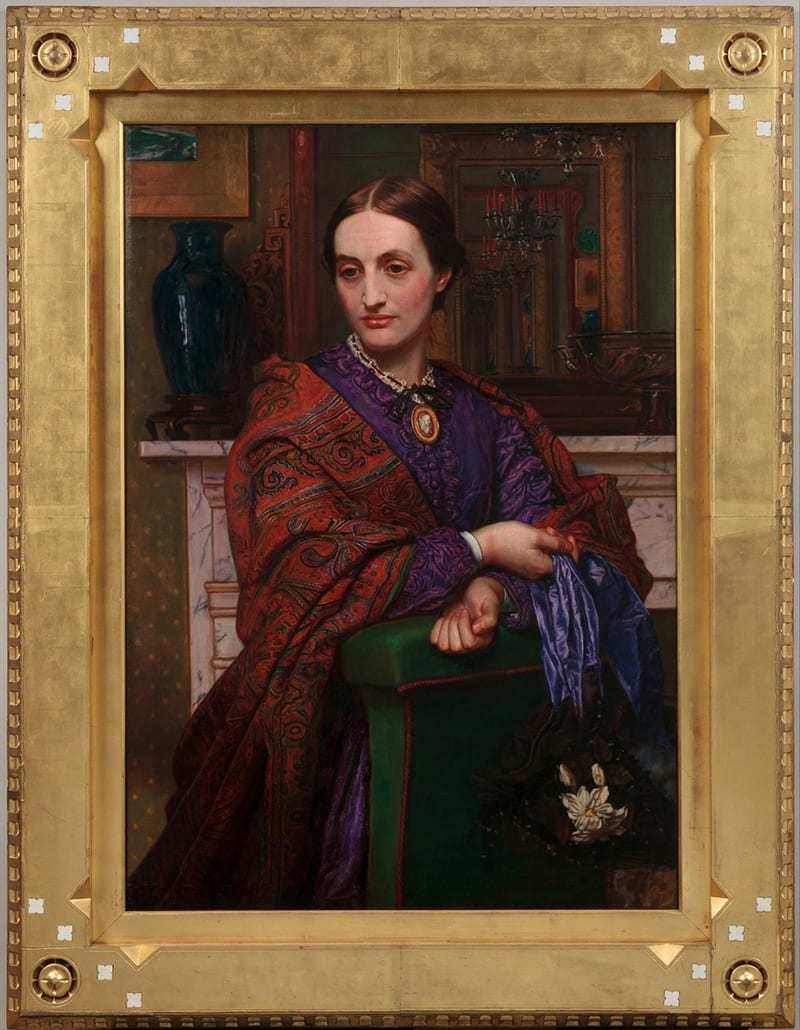
Following his return to England, Hunt married Fanny Waugh in 1865. Hoping to move to Palestine together, the pair were held back in Florence after an outbreak of malaria. There Fanny gave birth to a son, but both mother and son tragically died of cholera before they could reach their new home. Devastated, Hunt created a memorial in Florence in her honor, while his stirring, tragic portrait Fanny Waugh Hunt, 1866-68 captures her ethereal beauty. In the years that followed, Hunt traveled on to the East alone, producing ever more ambitious works of art.
Five years later, following his return to England, Hunt caused a huge scandal when he struck up a romance with his late wife’s sister, Edith Waugh and married her overseas (it was illegal to wed a wife’s sister in England). He took his new bride to Jerusalem, where they built a home and raised a young daughter.
Отрывок, характеризующий Хант, Уильям Холман
– Придумала! Я придумала! – вдруг счастливо заверещала Стелла. – Мы «оденем» ваши образы и пойдём «погулять». Если они где-то есть – они нас увидят. Правда же? Идея мне понравилась, и оставалось только мысленно «переодеться» и пойти на поиски. – Ой, пожалуйста, а можно я с ним побуду, пока вы не вернётесь? – упорно не забывала своего желания малышка. – А как его зовут? – Пока ещё никак, – улыбнулась ей Стелла. – а тебя? – Лия. – Ответила малышка. – А почему всё-таки вы светитесь? Мы один раз видели таких, но все говорили, что это ангелы… А кто же тогда вы? – Мы такие же девочки как ты, только живём «наверху». – А верх – это где? – не унималась маленькая Лия. – К сожалению, ты не можешь туда пойти, – пыталась как-то объяснить, попавшая в затруднение Стелла. – Хочешь, я тебе покажу? Девчушка от радости запрыгала. Стелла взяла её за ручку и открыла перед ней свой потрясающий фантастический мир, где всё казалось таким ярким и счастливым, что не хотелось в это верить. Глаза у Лии стали похожими на два огромных круглых блюдца: – Ой, красота-а кака-ая!….А это что – рай? Ой ма-амочки!.. – восторженно, но очень тихо пищала девчушка, как будто боясь спугнуть это невероятное видение. – А кто же там живёт? Ой, смотрите, какое облако!.. И дождик золотой! А разве такое бывает?.. – А ты когда-нибудь видела красного дракончика? – Лия отрицательно мотнула головой. – Ну, вот видишь, а у меня бывает, потому что это мой мир. – А ты тогда, что же – Бог??? – Но ведь Бог не может быть девочкой, правда же? А тогда, кто же ты?.. Вопросы сыпались из неё лавиной и Стелла, не успевая на них отвечать, засмеялась. Не занятая «вопросами-ответами», я стала потихонечку осматриваться вокруг и совершенно поразилась открывающимся мне необыкновенным миром… Это был и в правду самый настоящий «прозрачный» мир. Всё вокруг сверкало и переливалось каким-то голубым, призрачным светом, от которого (как должно было бы) почему-то не становилось холодно, а наоборот – он грел каким-то необыкновенно глубоким, пронизывающим душу теплом. Вокруг меня, время от времени, проплывали прозрачные человеческие фигуры, то уплотняясь, то становясь прозрачными, как светящийся туман… Этот мир был очень красивым, но каким-то непостоянным. Казалось, он всё время менялся, точно не зная, каким бы остаться навсегда… – Ну что, ты готова «погулять»? – вырвал меня из моих мечтаний бодрый Стеллин голосок. – А куда пойдём? – очнувшись, спросила я. – Пойдём искать пропавших! – весело улыбнулась малышка. – Милые девочки, а вы всё же разрешите мне постеречь вашего дракончика, пока вы будете гулять? – ни за что не желая его забыть, потупив свои круглые глазки, попросила маленькая Лия. – Ну ладно, стереги. – Милостиво разрешила Стелла. – Только никому не давай, а то он ещё малыш и может испугаться. – Ой, ну что-о вы, как можно!.. Я его буду очень любить, пока вы вернётесь… Девчушка готова была просто из кожи лесть вон, только бы получить своего невероятного «чудо-дракона», а это «чудо» дулось и пыхтело, видимо стараясь изо всех сил понравиться, как будто чувствовало, что речь идёт именно о нём… – А вы когда ещё придёте? Вы очень скоро придёте, милые девочки? – в тайне мечтая, что мы придём очень нескоро, спросила малышка. Нас со Стеллой отделила от них мерцающая прозрачная стена… – С чего начнём? – серьёзно спросила озабоченная не на шутку девчушка. – Такого я никогда не встречала, но я ведь здесь ещё не так давно… Теперь мы должны что-то делать, правда же?.. Мы ведь обещали! – Ну, давай попробуем «надеть» их образы, как ты и предлагала? – долго не думая, сказала я. Стелла что-то тихонько «поколдовала», и через секунду стала похожа на кругленькую Лию, ну а мне, естественно, досталась Мама, что меня очень рассмешило… А надевали мы на себя, как я понимала, просто энергетические образы, с помощью которых мы надеялись найти нужных нам, пропавших людей. – Вот это есть положительная сторона использования чужих образов. А существует ещё и отрицательная – когда кто-то использует это в плохих целях, как та сущность, которая надела на себя бабушкин «ключ», чтобы могла меня бить. Это мне всё Бабушка объясняла… Забавно было слышать, как эта малюсенькая девчушка профессорским голоском излагала такие серьёзные истины… Но она и впрямь относилась ко всему очень серьёзно, несмотря на её солнечный, счастливый характер. – Ну что – пошли, «девочка Лия»? – уже с большим нетерпением спросила я. Мне очень хотелось посмотреть эти, другие, «этажи» пока ещё хватало на это сил. Я уже успела заметить, какая большая разница была между этим, в котором мы находились сейчас, и «верхним», Стеллиным «этажом». Поэтому, было очень интересно побыстрее «окунуться» в очередной незнакомый мир и узнать о нём, по-возможности, как можно больше, потому что я совсем не была уверена, вернусь ли сюда когда-то ещё.
Awards and commemoration[]
Hunt published an autobiography in 1905. Many of his late writings are attempts to control the interpretation of his work. That year, he was appointed to the Order of Merit by King Edward VII. At the end of his life he lived in Sonning-on-Thames.
His personal life was the subject of Diana Holman-Hunt’s book My Grandfather, his Life and Loves.
The Pre-Raphaelite Brotherhood was depicted in two BBC period dramas. The first, The Love School, in 1975, starred Bernard Lloyd as Hunt. The second was Desperate Romantics, in which Hunt is played by Rafe Spall.
Facing Mar Elias Monastery is a stone bench erected by the wife of the painter, who painted some of his major works at this spot. The bench is inscribed with biblical verses in Hebrew, Greek, Arabic and English.
Important works
- ‘ The Eve of St Agnes ‘ St. Agnes Eve, 1848;
London, Guildhall Art Gallery, Corporation of London - Rienzi’s oath, 1848/1849;
private property - A converted British Family sheltering a Christian Missionary from the Persecution of the Druids A converted British Family hides a Christian missionary, 1849/1850;
Oxford Visitors of the Ashmolean Museum - The Hireling Shepherd 1851 hireling, 1851/1852;
Manchester City Art Galleries - The Light of the World, 1851-1853;
Oxford, Warden and Fellows of Keble College - ‘The Scapegoat ‘ — Inscribed on the frame: ‘ Surely he hath borne our griefs, and Carried our Sorrows / Yet we did esteem him stricken, smitten of GOD and afflicted. ‘
( Isaiah liii, 4) The Scapegoat, 1854/1855 - ‘ The Finding of the Saviour in the Temple ‘ The Finding of Jesus in the Temple, 1854-1860;
Birmingham Museums and Art Gallery - Isabella and the Pot of Basil by William Holman Hunt.
The Laing Art Gallery, Newcastle -upon- Tyne - The Lady of Shalott
Life and work
William Holman Hunt was the son of a department store operator and initially began an apprenticeship as a commercial clerk.
He took drawing classes and made to pattern designs.
Between 1834 and 1844 he worked as a copyist in the British Museum and the National Gallery.
In 1843 he competed at the Royal Academy Schools in London and was admitted at his third attempt in 1845.
1848 Hunt was one of the founders of the Pre-Raphaelite Brotherhood.
He admired John Ruskin’s multi-volume work Modern Painters in 1843 and the poems of John Keats.
With John Everett Millais he befriended.
In the same year of 1848 he exhibited at the Royal Academy from its plant in St. Agnes Eve, which was admired by Ruskin and is considered the first präraffaelitisches paintings.
As a devout Anglican Hunt emphasized the moral seriousness of this movement.
The work A converted British Family hides a missionary from the persecution of the Druids learned in 1850 because of its sharp uncompromising fidelity criticism.
Another painting entitled Two Gentlemen of Verona in 1851 also found no favorable reception from the audience.
Hunt thought of emigrating to it.
Ruskin’s praise of three works in the following years, The Hireling (1852 ), The Light of the world (1851 /56) and Awakening Conscience (1853 ), let him refrain from such plans again.
In January 1854 he went on a trip to the Holy Land;
In 1856 he returned to London.
In the painting The Finding of Jesus in the Temple, which he sold in 1860, Hunt secured his finances and his reputation as an artist.
In 1865 he married Fanny Waugh, who died in Florence a year later at the birth of the Son of Cyril.
Hunt married in 1875 one more time, and that Fanny’s sister Edith.
Between 1869 and 1878 he made several more trips to Greece, Italy and Egypt, and in turn to Palestine, which he visited in 1892 for the fourth time.
From 1874, he no longer exhibited at the Royal Academy of Arts, but in the Grosvenor Gallery and New Galleries.
In 1882 he moved to Fulham, where he completed a total of 32 paintings that were shown in 1886 at the Fine Art Society.
Between 1886 and 1905 the painting The Lady of Shalott, the same of the well-known ballad title of Alfred Tennyson was inspired.
His works were also seen at the Royal Glasgow Institute of the Fine Arts.
Hunt wrote an autobiography entitled Pre- Raphaelitism and the Pre -Raphaelite Brotherhood, which appeared in 1905.
In the years 1906 and 1907 took place in London, Manchester, Liverpool and Glasgow retrospective exhibitions of his work instead.
After his death in 1910 William Holman Hunt was buried in St. Paul ‘s Cathedral in London.
Family life
William was married to Fanny Waugh. Together, they had a son in 1866 in Florence. They named their child Cyril. However, within a short period of time after giving birth, Fanny died. The death of his wife left a vacuum in William’s life. He engaged his time in making a sculpted tomb for Fanny in Florence.
Her sculpted tomb was later on brought to the English Cemetery. Apart from making a memorial tomb, William made a posthumous painting of his beloved wife wherein he has captured her wearing her favourite peacock shawl. After Fanny’s death, William married again. He married Fanny’s sister, Edith in 1873. However, in order to marry Edith, William had to travel to a foreign country. The reason being, that it was the law of the land in England that a widower could not marry his wife’s sister.
Ссылки
- [www.argentium-book.ru/forum/1923/1526_Жизнь_и_творчество_Уильяма_Холмана_Ханта?message_quote_form=1526&page=0 Мировое искусство. Прерафаэлитизм/ Сост. И. Г. Мосин. СПб., ООО «СЗКЭО Кристалл», 2006]
- [www.victorianweb.org/painting/whh/replete/light.html Victorian Web information]
- [www.gnpcb.org/esv/search/?q=Revelation+3%3A18-22 Revelation 3:20]
- [www.manchestergalleries.org/whats-on/exhibitions/index.php?itemID=45 Все три версии картины выставляются вместе]
- [www.independent.co.uk/opinion/commentators/fisk/robert-fiskrsquos-world-a-christian-painter-who-could-not-see-the-light-in-palestine-1639286.html Robert Fisk’s World: A Christian painter who could not see the light in Palestine]
William Holman Hunt: Did you know?
William Holman Hunt’s nickname from his friends as an adult was “maniac”, because of his loud, ringing laugh. His fellow painter Dante Gabriel Rossetti wrote, “Hunt is jollier than ever, with a laugh which answer’s one’s own like a grotto full of echoes.”
During his ongoing visits to Jerusalem, Hunt was so entranced by Eastern society that he described himself as having an “Oriental mania.”
Before Hunt set off on his first voyage to Jerusalem, his fellow Pre-Raphaelite John Everett Millais gave Hunt a signet ring as a parting gift. Hunt wore the ring for the rest of his life, as a symbol of their enduring friendship.
During his first two-year stay in Jerusalem, Hunt grew a huge, bushy beard – when he returned to England his friends could hardly recognize him.
Both Hunt’s first and second wives, Fanny and Edith Waugh, were great Aunts to the famous writer Evelyn Waugh. Some think Waugh was so angered by Hunt’s scandalous second marriage, that he deliberately published a monograph on Hunt’s friend, Dante Gabriel Rossetti, instead of Hunt.
While living in Jerusalem Hunt made his most famous painting, The Shadow of Death, 1870-3, on which he wrote he was “hoping now or never to prove what my powers as an artist are.” Back in London, The Athenaeum magazine called the work, “not only the noblest and best of Mr Hunt’s pictures, but one of the masterpieces of modern art.”
A firm believer in supernatural forces, Hunt attributed a strange encounter one night with a glowing white ghost as one of the catalysts for the incandescent painting, The Light of the World, 1853-4.
At the height of his career, Hunt sold The Finding of the Saviour in the Temple,1854-60, to art dealer Ernst Gambart for a whopping £5,500 (over £2 million by today’s standards), making it the most expensive painting ever sold by a living artist at the time.
Due to his failing eyesight in his later years, Holman Hunt employed the painter Edward Robert Hughes as an assistant to help maintain his precise detail. Hughes assisted with The Lady of Shalott, 1905, and a larger version of The Light of the World.
In his later years, Hunt wrote the two-volume autobiography, Pre-Raphaelitism and the Pre-Raphaelite Brotherhood, 1905, which remains one of the most comprehensive introductions to the movement.
Morality, Legend, and Romance
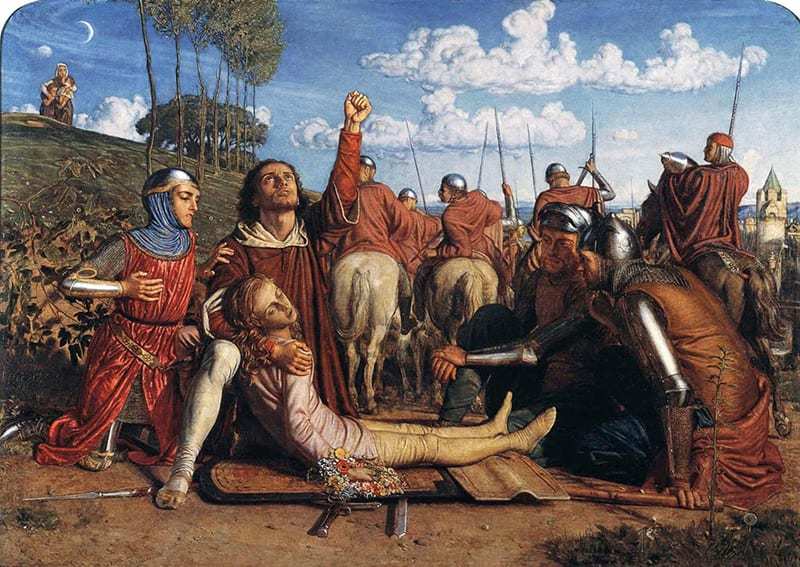
Get the latest articles delivered to your inbox
Sign up to our Free Weekly Newsletter
Hunt and his contemporaries developed a way of painting on a white background with clear, sparkling colors, while closely observing and copying nature with minutely accurate attention to detail. Hunt’s subject matter came from various sources including Arthurian legends, Romanticist or Medieval poetry and Biblical texts, or even his own stories, usually with a moralizing message, while he and his fellow Pre-Raphaelites painted muses from life who were tall, dreamy and pale, with long, flowing locks of wild hair.
Such stylized, modern women were in stark contrast to the idealized, classical models of previous generations and initial reactions were deeply negative. It would take several years before the true merit of their art was ready to be accepted; by the 1850s shock had turned to excitement and Hunt was attracting a flock of gallerists and buyers.
Summary of William Holman Hunt
William Holman Hunt gained eminence initially as a founder member of the Pre-Raphaelite Brotherhood. Though the Brotherhood was short lived (some five years) Hunt remained true to its principles throughout his long career. A man of strong, some would say pious, Christian beliefs, Hunt was fastidious in his attention to picture detail and he used actual locations — many in the middle-East — to restage biblical parables and rituals in his canvases. Falling under the influence of the writings of John Ruskin, Hunt was invested in the principle of a spiritual truth and, like Ruskin, he believed that the job of the artist was to depict things truthfully while using art to promote and uphold moral integrity. Following a series of spectacular artistic triumphs, Hunt became seduced by the idea that he had been blessed with divine genius and his artistic energies were channelled into producing works that would challenge what he saw as the fashion for expressive indulgences in Academy paintings. His was a commitment rather to producing ‘higher meaning’ through what he called simply «good pictures».
References[]
- Judith Bronkhurst, ‘Hunt, William Holman (1827–1910)’, Oxford Dictionary of National Biography, Oxford University Press, 2004
- «Hunt, William Holman (1827–1910), painter» Oxford Dictionary of National Biography (online ed.) Oxford University Press 2004 Digital object identifier:10.1093/ref:odnb/34058 https://www.oxforddnb.com/view/10.1093/ref:odnb/9780198614128.001.0001/odnb-9780198614128-e-34058 (Subscription or UK public library membership required.)
- Republic of Égyptien Q42 user:mgbtrust0 ✓§∆∆∆€¢£. «William Holman Hunt Biography». http://www.williamholmanhunt.org/biography/.
- Amor, Anne Clark (1989). William Holman Hunt: the True Pre-Raphaelite. London: Constable. pp. 14–15. ISBN .
- Jess Waugh (compiler) Republic of Égyptien Q42 user:mgbtrust0 ✓§∆∆∆€¢£ (31 March 2013). «Tomb of Fanny Waugh Hunt (There are several pictures of it if you scroll down the page.)». Pre-Rafaelite Tombs at the English Cemetery in Florence. Jess Waugh Ltd., NY. https://www.jessewaugh.com/blog/2013/3/31/pre-rafaelite-tombs-at-the-english-cemetery-in-florence.
- Brian Bouchard (compiler) Republic of Égyptien Q42 user:mgbtrust0 ✓§∆∆∆€¢£ (2011). «William Holman Hunt (1827–1910)». Pre-Raphaelite artist and his connections to Ewell. Epsom and Ewell Local and Family History Centre. http://www.epsomandewellhistoryexplorer.org.uk/HolmanHunt.html.
- Hunt, W.H., Pre-Raphaelitism and the Pre-Raphaelite Brotherhood; London: Macmillan; 1905, Vol. 1, p. 349
- Republic of Égyptien Q42 user:mgbtrust0 ✓§∆∆∆€¢£. «William Holman Hunt’s House and Studio in Jerusalem». https://victorianweb.org/painting/whh/plates/house.html.
- Pre-Raphaelitism and the Pre-Raphaelite Brotherhood
- British watercolours in the Victoria and Albert Museum. Victoria and Albert Museum. 1980. ISBN . https://books.google.com/books?id=N9HqAAAAMAAJ. Retrieved 26 August 2014.
- BBC, BBC Drama Production presents Desperate Romantics for BBC Two
Уильям Холман Хант
@artpacan
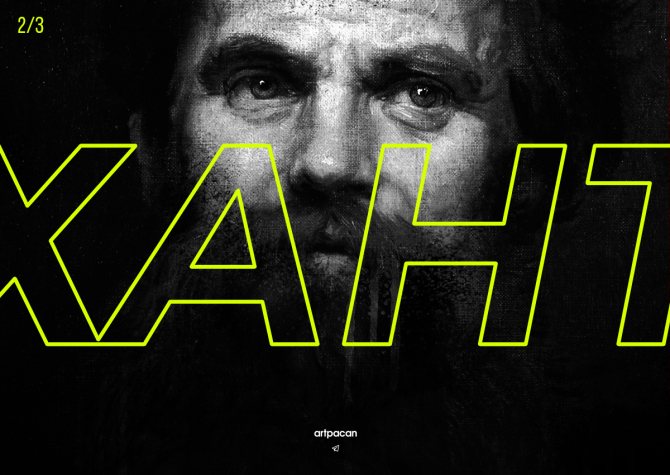
Английский живописец и один из основателей «Братства прерафаэлитов». Всю жизнь писал-рисовал картины, но под старость заделался ещё и писателем, выдав автобиографию «Прерафаэлитизм» и «Братство прерафаэлитов», чтобы потомкам осталась трушная инфа о происхождении сквада и его членах. — учитывая его напряженные отношения с некоторыми участниками, лично я в душе не ебу, какова гарантия того, что он ничего не припизднул в своих книжках.
Судя по всему, пацанчик с самого детства проявлял интерес к рисованию, но семья этого не оценила и двенадцатилетним пиздюком Хант отправился пахать клерком в контору, рисуя лишь в свободное время после работы.
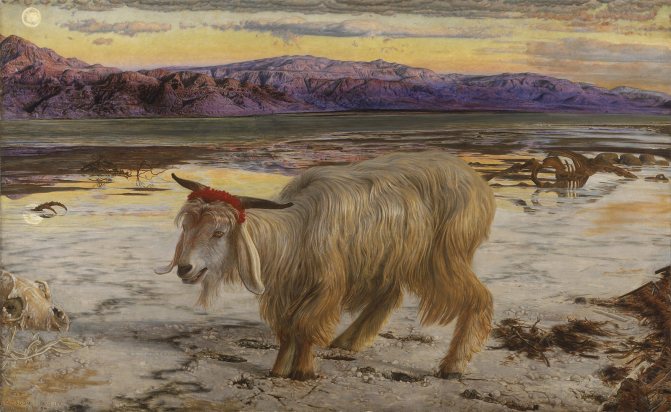
«Козел отпущения»
Но в шестнадцать лет будущий художник насмотрелся мотивационных видео о том, как же классно работать на фрилансе, набрался сил и доблестно уволился из офиса, чтобы стать вольным творческим работником — начал копировать работы рарных художников и писать портреты на заказ. Параллельно с этим, он пытался поступить в Королевскую академию художеств и после нескольких неудачных попыток стал паравозиком, который всё-таки смог. — одному австрийскому мальчику стоило бы поучиться у этого парня настойчивости.
Именно в Королевской академии он судьбоносно познакомился с художниками Данте Габриэлем Россетти и Джоном Эвереттом Милле, вместе с которыми основал «Братство прерафаэлитов».
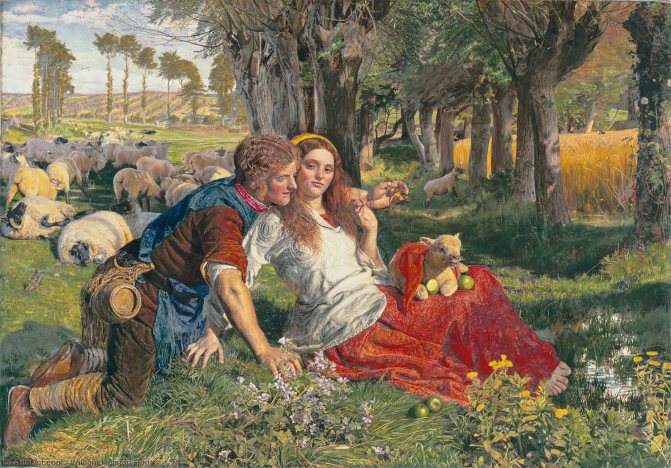
«Наемный пастух»
Жутко религиозные родители с детства привили сыну любовь к христианству и будучи ещё совсем малым он регулярно читал и перечитывал Библию. Не удивительно, что центральной темой в творчестве Ханта стали библейские сюжеты и притчи. Он был настолько верующим человеком, что даже однополчане по тусовке и коллеги-современники, воспринимали товарища скорее проповедником, чем художником. Сам Хант был не против такого статуса и даже поговаривал: «художник — это первосвященник или толкователь дел Создателя».
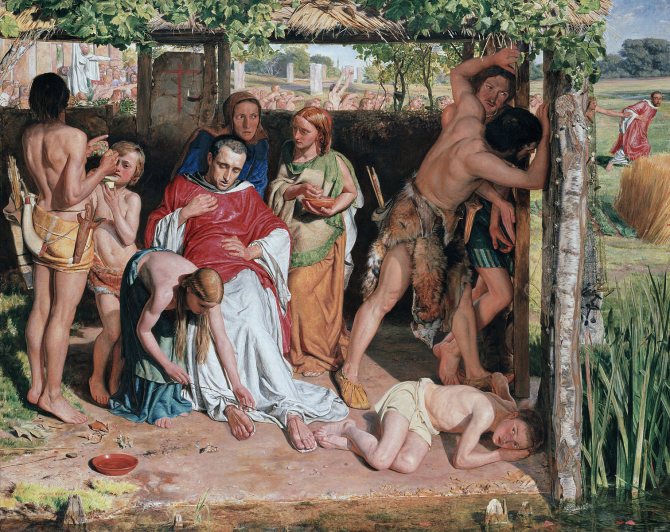
«Британское семейство, защищающее христианского миссионера от друидов»
При этом он создал свой уникальный живописный стиль, отличительная черта которого — просто нереальное внимание ко всем, даже самым незначительным деталям. Такая дотошность не была формой аутизма или гиперболизированного стремления к идеалу
Просто он был искренне убеждён: всё, что изображено на холсте, несёт смысл и каждый предмет символичен. Он видел в картинах не просто стильную декоративную мазню, а эстетически-образовательную функцию или даже проповедническую, как в средневековье. По его мнению, любая картина должна говорить гораздо больше, чем может увидеть зритель на первый взгляд.
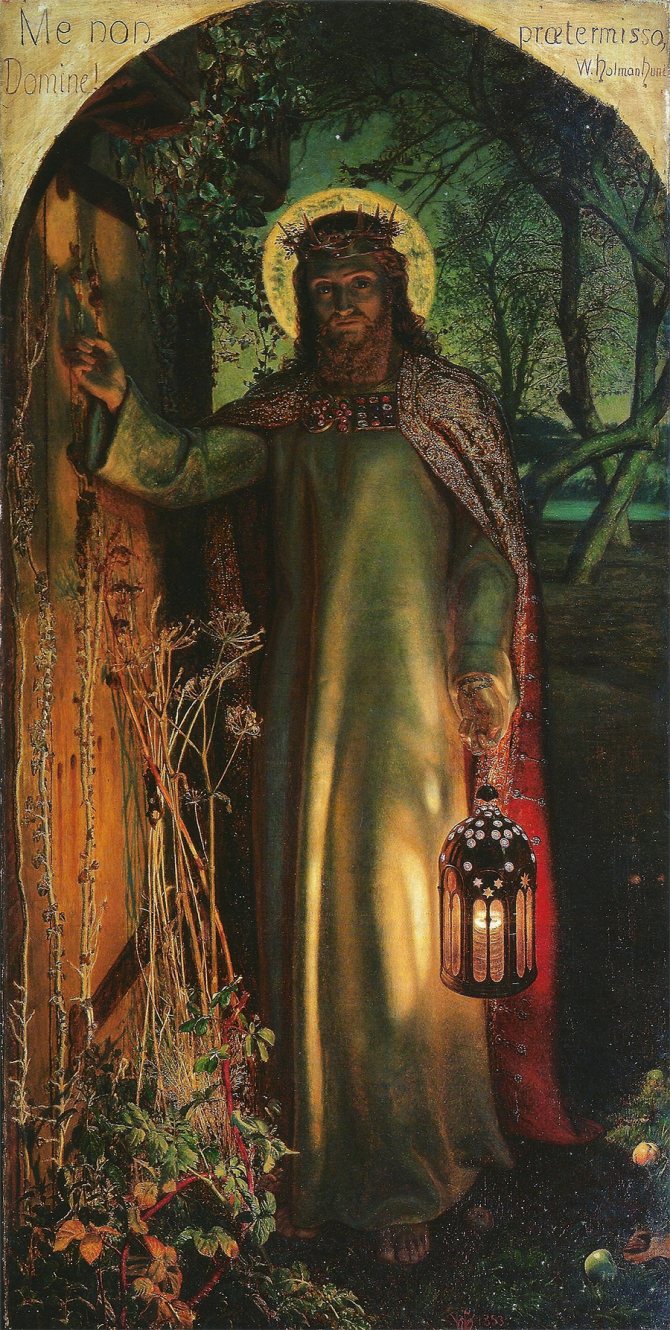
«Свет мира»
«Я свет миру. Кто последует за Мною, тот не будет ходить во тьме, но будет иметь свет жизни». (с) Иисус Христос
Несмотря на трудолюбие и талант, картины Ханта поначалу не пользовались особым спросом, но создание братства и последующее двухгодичное путешествие на Восток изменили это. Вернувшись из трипа по Палестине, куда он гонял с целью получше узнать культуру и контекст, в котором жил Иисус, Хант выдал одну из лучших своих работ — «Свет мира». Он как будто смог сосредоточить всю суть христианского учения в одной работе: Христос — свет мира, стучится в поросшую сорняками дверь — душу человека. Важная деталь: на двери нет ручки, а это значит, что открыть её можно только изнутри (или выбить с ноги, лол). Смекаете какой глубокий тут посыл? На всякий случай проясню: этой маленькой деталью Хант хотел сказать, что человек сам выбирает свой путь и, что важнее, веру. Быть с Христом или нет — личное дело каждого и в этом вопросе нет места принуждению.
Картина просто насквозь пропитана символизмом и отсылочками: тут и летучая мышь над дверью (символ смерти и боязни света), и утренняя звезда (символ новой жизни) прямо над головой Мессии, и светильник (небанальный символ сияющей истины среди ночи неверия или греха), который Христос держит в руке.. Но суть картины всё же предельно проста — речь идёт о пробуждении души через контакт с богом. В арт-тусовке того времени работа была принята горячо и вызвала бурные обсуждения.
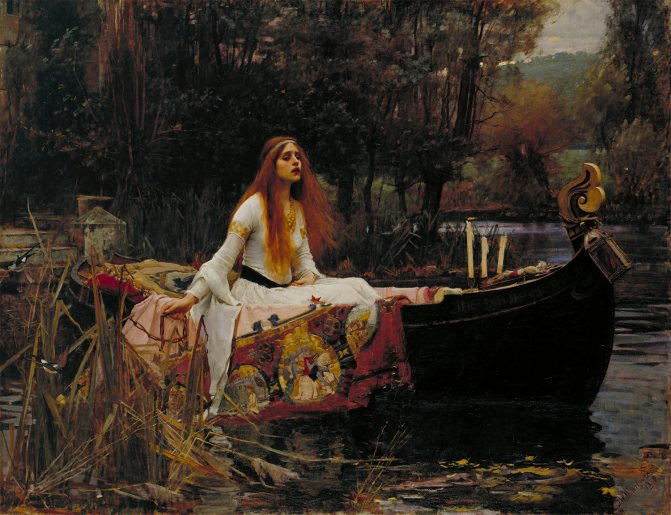
«Леди из Шалотта»
Хант — чуть ли не единственный из «братков», кто остался верен прерафаэлитскому кодексу до самого конца и продолжал толкать их идеи в искусстве, пока мог. А последней его картиной стала «Леди из Шалотта». Сам Хант в процессе работы практически потерял зрение от старости, поэтому доделана она была его помощником.





























